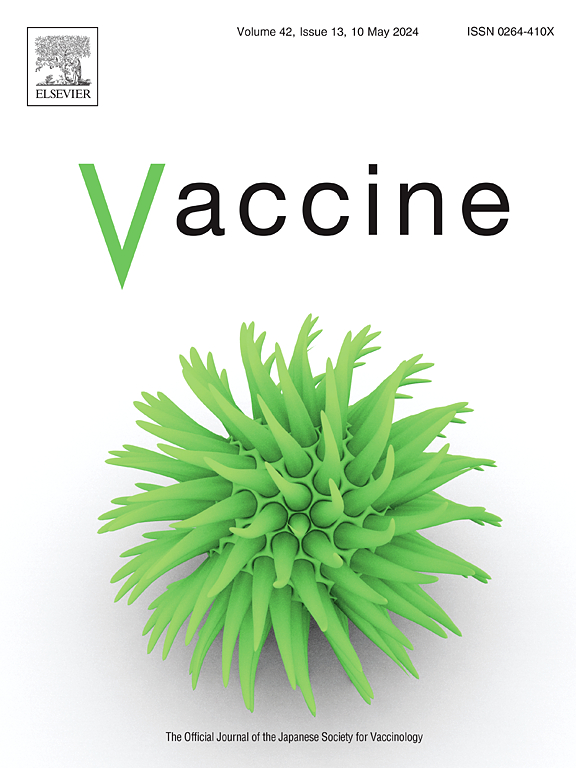未接种疫苗儿童的不同照料者对儿童COVID-19疫苗接种的犹豫和信心
IF 4.5
3区 医学
Q2 IMMUNOLOGY
引用次数: 0
摘要
了解与儿童COVID-19疫苗接种犹豫不决相关的因素对于确定提高疫苗接种率的策略非常重要。我们的目标是描述尚未为孩子接种COVID-19疫苗的护理人员对COVID-19疫苗接种的看法。方法:从2022年7月到2023年2月,在IDeA州儿科临床试验网络内的15个州招募未接种COVID-19疫苗的儿童的照顾者,参与一项COVID-19疫苗通信电话应用程序的随机对照试验。招募站点为大量来自农村地区或非西班牙裔白人背景的儿童提供服务。在基线时,护理人员回答了SAGE疫苗犹豫量表(VHS)中的问题,以及关于COVID-19可信信息来源的问题。我们使用卡方检验比较了农村、种族和民族的反应,并使用VHS评分综合结果的多变量建模来确定与疫苗犹豫相关的因素。结果共纳入护理人员725人;512人完成了基线调查。许多护理人员居住在农村地区(34.9%),近一半是非白人(47.3%)。超过80%的人多少或强烈同意疫苗很重要,儿童疫苗是有效的,接种疫苗是保护儿童免受疾病侵害的好方法。农村护理人员比非农村护理人员更有可能表示,他们通常会按照医生的建议接种儿童疫苗(46.93%对37.00%,p <;.0021)。在多变量模型中,与白人看护者相比,亚洲人、夏威夷原住民、其他太平洋岛民或多种族看护者以及黑人或非裔美国看护者的组合组有更高的疫苗犹豫(分别为25.25、25.91和22.50)(p <;。)。结论:在我们引导工作以建立疫苗信心的同时,本研究为其他研究方向提供了支持,以更好地了解特定人群,并可以进一步复制以观察其他疫苗的意图。本文章由计算机程序翻译,如有差异,请以英文原文为准。
Hesitancy and confidence in pediatric COVID-19 vaccination among diverse caregivers of unvaccinated children
Introduction
Understanding factors associated with hesitancy about pediatric COVID-19 vaccination is important for identifying strategies to improve vaccination rates. Our objective was to describe beliefs about COVID-19 vaccination among caregivers who had not yet vaccinated their children against COVID-19.
Methods
From July 2022 to February 2023, caregivers of children unvaccinated for COVID-19 across 15 states within the IDeA States Pediatrics Clinical Trial Network were recruited into a randomized, controlled trial of a COVID-19 vaccine communication phone app. Recruitment sites served high numbers of children from rural areas or of backgrounds other than non-Hispanic White. At baseline, caregivers answered questions from the SAGE Vaccine Hesitancy Scale (VHS), and questions about trusted sources of information about COVID-19. We compared responses by rurality, race, and ethnicity using chi-square tests, and used multivariable modeling of a composite outcome of summed VHS scores to identify factors associated with vaccine hesitancy.
Results
A total of 725 caregivers were randomized; 512 completed the baseline survey. Many caregivers lived in a rural area (34.9 %) and nearly half were of non-White race (47.3 %). Over 80 % somewhat or strongly agreed that vaccines are important, that childhood vaccines are effective, and that vaccination is a good way to protect children from disease. Rural caregivers were more likely than non-rural caregivers to state that they generally do what their doctor recommends with regard to childhood vaccines (46.93 % vs. 37.00 %, p < .0021). In the multivariable model, the combined group of Asian, Native Hawaiian, Other Pacific Islander or multiracial caregivers, and Black or African American caregivers, had a higher vaccine hesitancy compared to White caregivers (25.25, 25.91, 22.50 respectively) (p < .0001).
Conclusions
As we navigate work to build vaccine confidence, this study provides support for additional directions of study to better understand particular populations and could be further reproduced to look at intentions with other vaccines.
求助全文
通过发布文献求助,成功后即可免费获取论文全文。
去求助
来源期刊

Vaccine
医学-免疫学
CiteScore
8.70
自引率
5.50%
发文量
992
审稿时长
131 days
期刊介绍:
Vaccine is unique in publishing the highest quality science across all disciplines relevant to the field of vaccinology - all original article submissions across basic and clinical research, vaccine manufacturing, history, public policy, behavioral science and ethics, social sciences, safety, and many other related areas are welcomed. The submission categories as given in the Guide for Authors indicate where we receive the most papers. Papers outside these major areas are also welcome and authors are encouraged to contact us with specific questions.
 求助内容:
求助内容: 应助结果提醒方式:
应助结果提醒方式:


